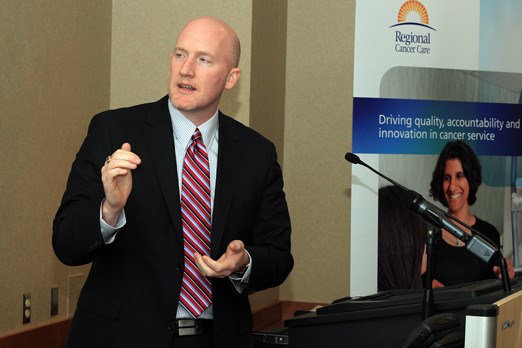Cancer patients and those in the diagnosis stage will have a much greater say in the way they are treated under the region’s latest cancer-care strategy.
Michael Power, regional vice-president for Cancer Care Ontario, on Monday unveiled the four-year plan, which puts an emphasis on improved emotional and informational support, which surveys show have been lacking in Northwestern Ontario hospitals and cancer care facilities.
“Our patients are providing feedback that says we need to do a better job,” Power said Monday, at a news conference that also detailed the provincial strategy.
Power added with so many stops and starts in the system between diagnosis and treatment, it’s no wonder patients feel left out of the loop.
Power said the cancer journey is a complex one, with many starts and stops over a period of years, typically. For survivors, whose numbers are on the rise, that journey could take decades.
The plan, he said, in part centres around the consumerism that is prevalent in today’s society, an era where people book their own hotels and flights, and shop from the comfort of their own homes.
Health care should be no different.
“Our health-care system shouldn’t be any different. Our patients and families want that. We have to be responsive. We need to put strategies in place that allow patients to have a more active voice and have control over their care,” Power said.
That could mean everything from booking one’s own mammography to an active personalized medical strategy that will allow patients the immediate electronic opportunity to see where they are on the treatment timeline and what they can expect in the coming weeks, months and years.
It also means a more personalized treatment plan, that takes into consideration the different make-up of individuals instead of provide a one-treatment-fits-all solution across the board.
“We’re moving away from treating patients with the same disease type with the same therapy, the same chemo, to actually treating patients with a chemotherapy that responds to your molecular makeup,” Power said. “So we’ll be making decisions at a personal level as opposed to a disease-site level.”
The diagnosis stage has also been tackled, with area officials looking to ensure efficiency and ease for patients bombarded with tests recommended by physicians or dictated by their stage in life.
Using a 52-year-old woman as an example, Power said while most people know the benefits to cancer screening, not everyone is heeding the call, for a variety of reasons.
“It’s difficult when we say there are benefits to breast cancer screening and the week after we say you should have had your cervical screening and then three months later we remind you that you should have had your colon cancer screening,” Power said.
“It’s a disjointed and cumbersome system with lots of overhead and we miss a lot of people he said.”
The solution is to bundle the tests and promote the all-in-one screening appointment.
“We want to say … all of this is important and why don’t we do this all at once, on this day, on this visit or these series of visits,” Power said. “We know that will resonate.”
Cancer survivor Dawn Powell, diagnosed in 2007 and now a patient advisor at the Regional Hospital, said she likes the focus of the latest cancer-care strategy at the local level.
“It’s exciting. A lot of what patients want is to be very involved in their cancer care. They want to make decisions, be part of a team. What this plan does is provide opportunity for them to have access to the information they need. There will be an advisory council developed so that patients are represented throughout the province. And we’ve had this in Thunder Bay for a while,” Powell said.
Outgoing Cancer Care Ontario president and CEO Terrence Sullivan said the regional plan, which essentially allows the implementation of the provincial plan, taking into consideration local challenges, said things like a publicly available cancer risk predictor is just a start.
The Northwest, with its large Aboriginal population, greater distances between communities and less-than-healthy lifestyle of many residents, has plenty of its own challenges, a prime example of why each of the 14 Local Health Integration Network regions is being given a say in implementation.
“Above all else, you’ve got the need to provide supportive resources to a very highly dispersed population. The plan that has been laid out here for the Northwest is quite clear in hitting both the softer size of supportive care – the building out of a palliative care team of family physicians – and also targeting real improvements in patient outcomes,” Sullivan said.
The strategy also includes the replacement of imaging equipment, to the tune of $12 million and other equipment totaling an additional $3 million.
Ontario-wide, it’s estimated that 45 per cent of men and 40 per cent of women are likely to develop cancer in their lifetime. Annual diagnosis rates more than doubled between 1982 and 2006.
Sign in or register
- Messages
- Post a Listing
- Your Listings
- Your Profile
- Your Subscriptions
- Your Likes
- Your Business
- Support Local News
- Payment History
Registered Users
Already have an account?
New Users
Create a free account.
